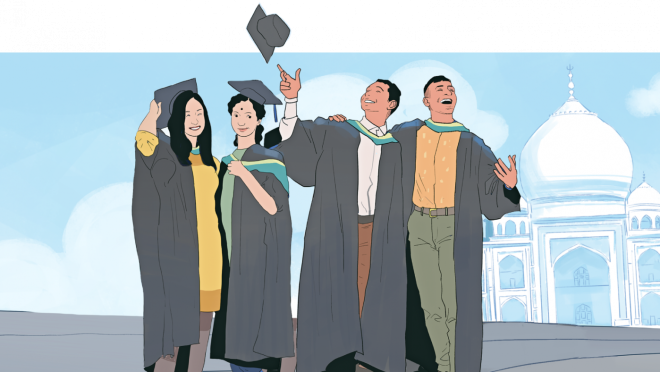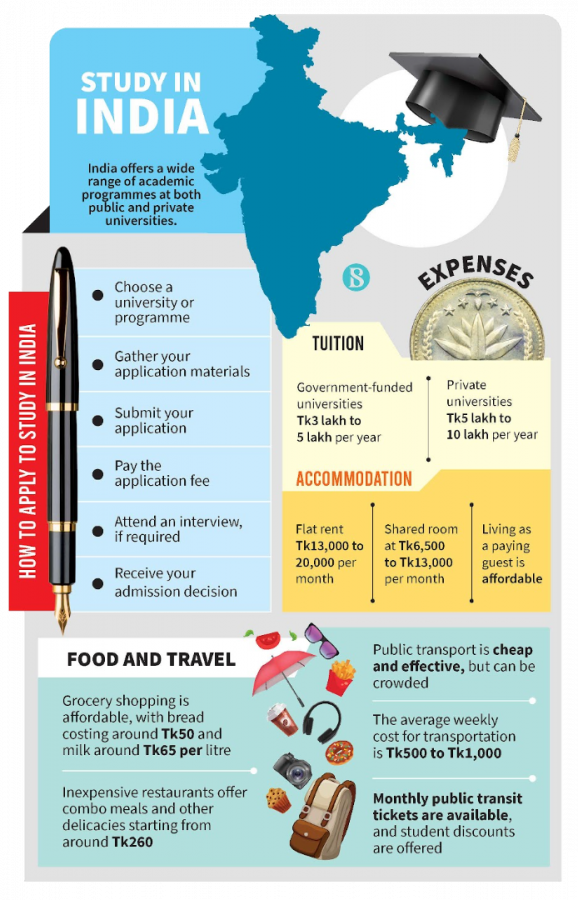A guide for Bangladeshi students looking to study in India
A guide for Bangladeshi students looking to study in India

Unbeknownst to most Bangladeshi college aspirants, pursuing higher education in India can be a great opportunity to study in globally recognised universities like IIT and avail scholarships like the ICCR
After completing his HSC from Notre Dame College in 2016, Dipto Saha prepared for admissions to engineering universities in Bangladesh. He eventually got into EEE in KUET (Khulna University of Engineering and Technology).
And Dipto was passionate about studying EEE. While studying at KUET, he came across an Indian government scholarship. His heart leaned towards India’s IITs —not only for their prestige but also for the fact that Sundar Pichai, CEO of Google and one of his idols, studied in one of these IITs.
Dipto applied for the scholarship without much expectation and any concrete plan of studying in India, or any other foreign country for that matter. There was no application fee and no need for IELTS or TOEFL. He had to only clear a written exam and viva conducted by the Indian High Commission.
To his surprise, he received the scholarship confirmation in June 2017, almost at the end of his first semester at KUET. “It was unexpected for me. Though I had started my classes at Kuet, I had to take this chance because I had heard a lot of good things about IITs”, said Dipto.
“When I first heard about the scholarship, I was interested in the fact that the application process was fairly simple. The whole process is an online based application, where you have to submit a scanned copy of your academic certificates, passport and a few other documents.”
This fully funded scholarship – ICCR scholarship – is one of the popular ways Bangladeshi students get to study in Indian public universities. It is fully funded by the Indian government. In addition to the ICCR, there are various other ways for students to pursue their studies in India.
Private universities in India also provide opportunities for international students. However, the application process for these universities is not centralised and can vary significantly from one institution to another.
The Business Standard has explored different ways for students to pursue their studies in India, offering valuable insights into the process. Interviews with students who have studied in India have provided a wealth of information on what to expect, hopefully making it easier for aspiring students to navigate the path to their dreams.

Why study in India?
India has, in fact, rapidly emerged as a leading higher education hub in South Asia. The country boasts several top-tier universities ranked within the top 1,000 worldwide. There are four Indian universities within QS’s top 250 rankings and in total 41 universities in QS’s top 1,000 rankings.
Every year, a significant number of students travel to India, both with and without scholarships. The cost of education in India is comparatively lower than Western countries, even at top universities, making it an affordable option for Bangladeshi students.
According to a 2022 survey conducted by the All India Survey of Higher Education (AISHE), Bangladesh ranks third in terms of the number of foreign students studying in India. For instance, in the academic year 2019-20, 2,259 Bangladeshi students enrolled in Indian universities.
IITs are not only famous in India but are also recognised in Western countries. India also has other universities such as Amity University, Vellore Institute of Technology etc. – which are equally good at business and social science subjects.
Studying with ICCR Scholarship
The Indian Council for Cultural Relations (ICCR) scholarship is arguably the most sought-after option for aspiring Bangladeshi students. This prestigious scholarship provides full financial support to its recipients for their studies in Indian public universities.
In the 2021-22 academic year, 267 Bangladeshi students availed themselves of the ICCR scholarship to pursue undergraduate, postgraduate, and PhD programs in various fields, including Engineering, Science, Arts, Law, and Culture, in premier government educational institutes such as the Indian Institutes of Technology (IITs), National Institutes of Technology (NITs), Rabindra Bharati University, and others.
Dipto Saha was grateful for the opportunity to study at IIT Indore with an ICCR scholarship. He described the facilities as top-notch, including modern classrooms, well-equipped laboratories, and state-of-the-art research facilities.
The faculty members had extensive knowledge and experience, making the learning experience exceptional. According to Dipto, “Getting here is a life-changing experience as an international student. It provides an opportunity to pursue academic and career goals in a multicultural and intellectually stimulating environment while receiving full financial support.”
The scholarship covers all of the student’s expenses, including tuition fees, accommodation, travel, and a monthly stipend, which allows them to focus solely on their studies without having to worry about financial constraints.
And according to Dipto, he used to get 18,000 Indian rupees per month as a stipend. For graduate and PhD programmes, the stipend is even higher. For instance, it is 22,000 Indian rupees for a PhD student, as stated on the ICCR website.
Studying without scholarship
India is home to quite a few private universities. As per the data of AISHE, only 267 of the total 2,259 students went to pursue higher education in India with scholarships. That means the lion’s share of students go there without scholarships.
However, the upside is that the expenses in Indian private universities are not that high. In most cases, the education cost is similar to that of Bangladeshi universities.
Take Mehedy Hasan, for example, who recently graduated with a B.Tech in Computer Science from Lovely Professional University (LPU) in Punjab. His per semester cost was 130,000 Indian rupees. According to him, for his four-year undergraduate programme, his total tuition fees were around 520,000 INR. In Bangladeshi currency, that translates to roughly Tk600,000. In addition, with a monthly 15,000 rupees for living expenses, someone could lead a very comfortable life there, he added.
“When you compare Indian private universities’ course fees and other expenses, you will see that on average they are cheaper. What is more, accommodation, food and other living expenses are way cheaper in India. At the same time, their degrees are valued in Western countries. That’s a huge plus point,” explained Mehedy.
Currently, Mehedy is pursuing his masters in CS at Oregon State University. According to him, Indian private universities are known for providing high-quality education, which can help students gain valuable knowledge and skills that are highly valued in the job market.
“But more than that, it’s about the total experience. Though we have some cultural similarities, many things differ between the countries. Studying in a foreign country opens up opportunities and new understanding.


